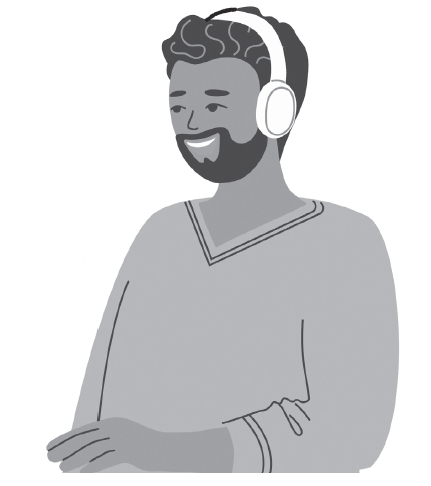CHAPTER 8
Listening Skills

Listening is a skill. Generally, it’s not taught in school. Teachers or professors test around the edges of listening. On exams, students are asked questions to see if they heard what the teacher said.
Many people assume listening is a fixed skill—that is, we were born with the knowledge of how to hear, and you’re either good at it or not.
Interestingly, listening is simple. Practice is essential. Honing this skill takes hard work, but it’s not complex.
ACTIVITY
58
What Does Listening Mean to Me?
Do you want to be a better listener? Listening requires your attention. It means listening to content, how the content is told, and how the person speaking uses their body to communicate.
LTIO: What does listening mean to your work? What percentage of your time do you spend listening to someone else?

Research studies that give people something to listen to and then test them reveal that humans remember only about 50 percent of what they heard. After eight hours, they will remember about one-third of what they heard. Yet these people believe they are good listeners.
Active listening means you listen without judging and without figuring out what you will say next or when you can jump into the conversation. Active listening also means inferring what the speaker means beyond their spoken words.
LTIO: What do you think is required to listen well? Patience is one example. List two others:

ACTIVITY
59
Listening at Three Levels
The CoActive Training Institute, a top American professional coaching certification organization, teaches three listening levels.1 You can think of these levels as filters through which listening occurs. We’ll cover the first two levels as it takes a bit of practice to get to the third level.
Level I: Listening To—At the first level of listening, you primarily listen to content. This level is where note-taking is crucial, specifically about what the other person says. You should have little difficulty remembering someone’s words if you take notes. Take as many notes as you can; more notes are better.
If you want to take notes on your computer, you can do so as long as your computer doesn’t make clicking sounds so as to not annoy customers. Zoom has upgraded its platform with a background-noise cancellation feature, which is switched on by default. Many studies show that taking notes on paper helps you remember better, but will you take down more words when entering them on a computer?2 The choice is yours. Remember to tell your customer you are taking notes; otherwise, they might think you aren’t paying attention. You also need to listen to your own internal conversation at this level. What are you saying to yourself?
Level II: Listening For—At the second level, you are listening for what the person possibly means underneath their words. When you take notes on paper, draw a line down the middle of the sheet and put your “listening for” notes side by side with the main content. Many of these listening-for notes might be in the form of questions, such as “What did they mean?”
LTIO: The next time you listen to a customer, set yourself up for note-taking, whether on a computer or paper. Tell your customer you’ll be taking notes, then begin. Observe the improvements in your ability to stay focused, remember what was said, and ask better questions.
Notes:

ACTIVITY
60
Paraphrasing Helps!
Paraphrasing is a restatement of a conversation in different words.
LTIO: You’ll need a partner for this activity.
1. Ask your partner to talk for about two minutes on a subject on which the two of you disagree. Don’t take any notes: just listen. 2. Then paraphrase what you heard—without giving any additions, showing your emotions, or revealing your position. Just listen and paraphrase; don’t repeat word for word but instead what you heard using different words.
3. If your partner feels they were accurately paraphrased—without any side comments or emotions, just facts—then you have finished the first practice session. Try it again so you have at least two practice sessions on different topics.
4. If your partner feels that you didn’t accurately cover everything they said, or you put a different spin on their words, then do it again until your partner agrees that all you did was paraphrase.
5. If you are both going through this workbook, you should take turns paraphrasing.
When you practice listening with attention, you have to stay completely focused. You will probably find this hard—everyone does!
LTIO: What’s the challenge with paraphrasing?

Why is this skill set critical in complaint handling?

How much do you allow your interpretations to get in the way of clearly understanding what someone else is saying?

Notes:

ACTIVITY
61
Listening to Deepen Rapport
In activities 30, 31, and 32 we discussed how rapport exists when two people develop a shared feeling of positive communication.
When you listen to someone, you choose between two ways of communicating: you can (1) decide to concentrate on the differences between you, or (2) emphasize the similarities between you. In the latter method, you focus on the topics you agree on, your past experiences, and the things you share in common, especially your shared goals.
You may be thinking, “Wait a minute! What goals do I share with my customers?” You share at least one goal—you both want this complaint handled
• As respectfully as possible, even if your customer wants to vent. Respect can more easily follow if you start by saying hello to your customer in a positive, upbeat way.
• Quickly, with speed. If your customer says, “I’m in a real rush today,” you can create rapport, by saying, “Great! Let’s get right to it.”
• So no additional problems are created. In other words, you both want the complaint to be solved accurately. You can create rapport with your customer by checking, “Does this suggestion sound right to you?”
• In a way that leaves both of you feeling good. Set this as your goal, and you’ll probably find that the feeling of positive communication will happen naturally.
LTIO: By this time in the workbook, you probably have upward of a dozen or more things to try out. We recommend writing these ideas on a sheet of paper and putting it somewhere you can see it. The next time you begin to interact with your customer, choose one of these ideas and focus on making sure that goal gets achieved in your conversation.
Notes:

ACTIVITY
62
Listening by Using Pacing
Pacing is probably one of the best tools to deepen rapport. To use the concept of pacing is to hold up a mirror to another person so they see in your actions and statements a duplicate of their own.
Pacing is not mimicking or aping. It’s subtle because the moment the other person sees you mimicking them, the game is over, they will know what you are doing.
Pacing is, therefore, a question of gently entering into another person’s expression of the world by mirroring their body language, voice, vocabulary, and mood. Here are two points to understand about pacing.
• Pacing occurs unconsciously when people like each other or have been friends for a while. The two people understand each other. When people are in love, any outsider can see evidence of pacing in their body language.
• Pacing can be used consciously when rapport does not exist naturally. Pacing creates a feeling of “I know you, and I like you.” Nothing has to be said about the fact that you may have just met each other. Two strangers can achieve this same feeling of knowing each other because they are pacing each other.
The highest goal in communication is to achieve rapport. One of the best tools for this is pacing.
What can you pace? Obviously, it makes a difference whether you are virtual or in person. But even while communicating through a chat box, you can mirror speech patterns and feelings. You can also practice pacing the three observable behaviors listed below wherever you are; it doesn’t have to be with a customer.
• Body language—You can pace a sitting or standing position, movement, position of the legs, arm movements, overall posture, head angle, and facial expression.
• Speech—You can pace speed, tone, volume, and choice of words.
• Words—You can pace attitudes, beliefs, enthusiasm, tolerance, and feelings.
LTIO: The next time you are with a customer, pace their body language, speech, or words. What happened? How did pacing help you listen? What was the mood you created?

Notes:


SELF-CHECK: Listening Skills
What are three differences between “listening to” and listening for”?

Which is more important as a complaint handler, “listening to” or “listening for”? Why? Yes, they are both important, but choose one and make an argument for that type of listening.

What are three reasons why being able to paraphrase what a customer says is important? What advantages will you have if you can paraphrase accurately?

